steering TOYOTA PRIUS C 2012 NHP10 / 1.G Quick Reference Guide
[x] Cancel search | Manufacturer: TOYOTA, Model Year: 2012, Model line: PRIUS C, Model: TOYOTA PRIUS C 2012 NHP10 / 1.GPages: 31, PDF Size: 1.11 MB
Page 3 of 31
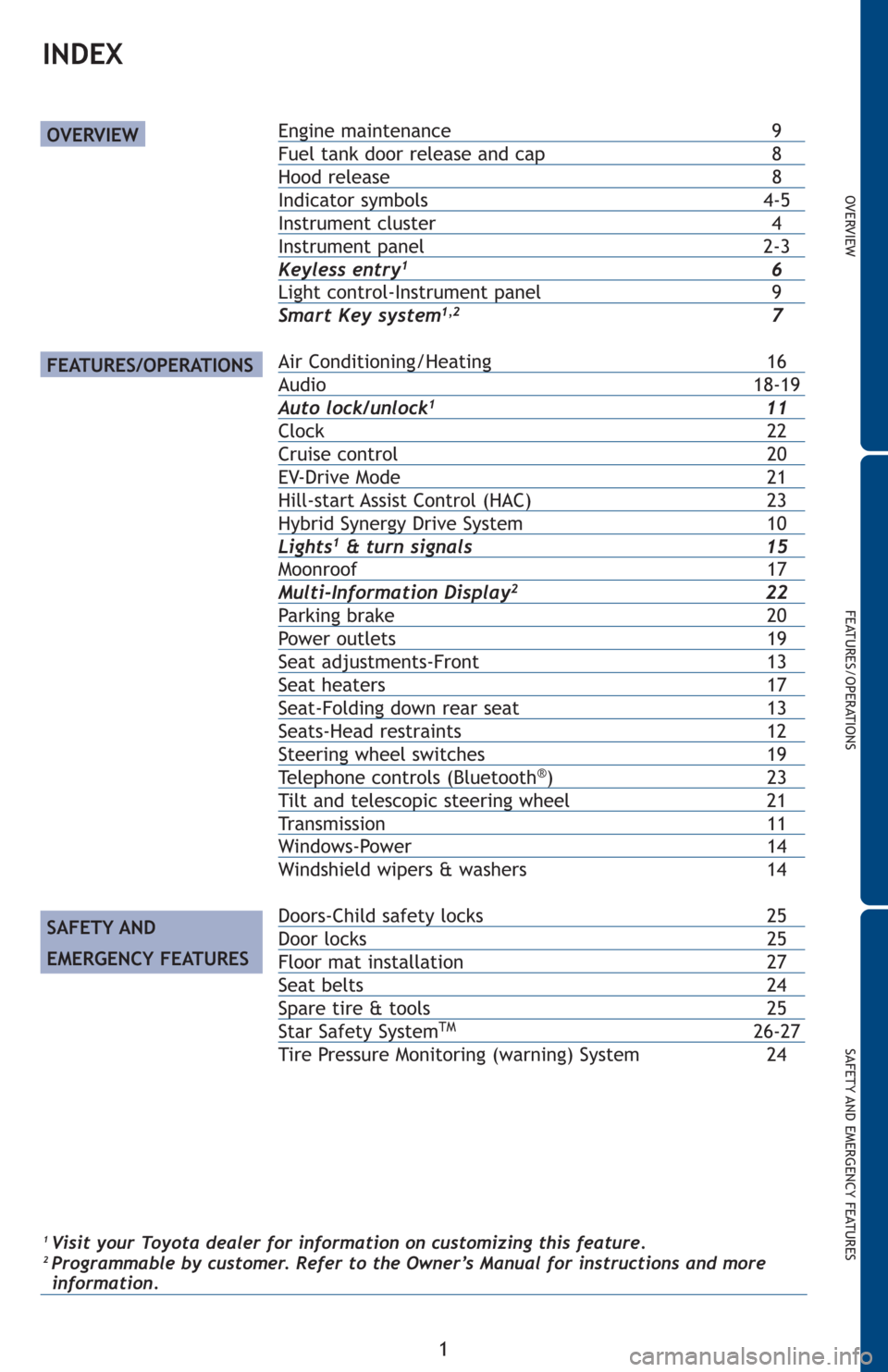
OVERVIEW
FEATURES/OPERATIONS
SAFETY AND EMERGENCY FEATURES
1
INDEX
OVERVIEW
FEATURES/OPERATIONS
SAFETY AND
EMERGENCY FEATURES
Engine maintenance 9
Fuel tank door release and cap 8
Hood release 8
Indicator symbols 4-5
Instrument cluster 4
Instrument panel 2-3
Keyless entry16
Light control-Instrument panel 9
Smart Key system1,27
Air Conditioning/Heating 16
Audio 18-19
Auto lock/unlock111
Clock 22
Cruise control 20
EV-Drive Mode 21
Hill-start Assist Control (HAC) 23
Hybrid Synergy Drive System 10
Lights1& turn signals 15
Moonroof 17
Multi-Information Display222
Parking brake 20
Power outlets 19
Seat adjustments-Front 13
Seat heaters 17
Seat-Folding down rear seat 13
Seats-Head restraints 12
Steering wheel switches 19
Telephone controls (Bluetooth®)23
Tilt and telescopic steering wheel 21
Transmission 11
Windows-Power 14
Windshield wipers & washers 14
Doors-Child safety locks 25
Door locks 25
Floor mat installation 27
Seat belts 24
Spare tire & tools 25
Star Safety SystemTM 26-27
Tire Pressure Monitoring (warning) System 24
1Visit your Toyota dealer for information on customizing this feature.2 Programmable by customer. Refer to the Owner’s Manual for instructions and more
information.
Page 4 of 31
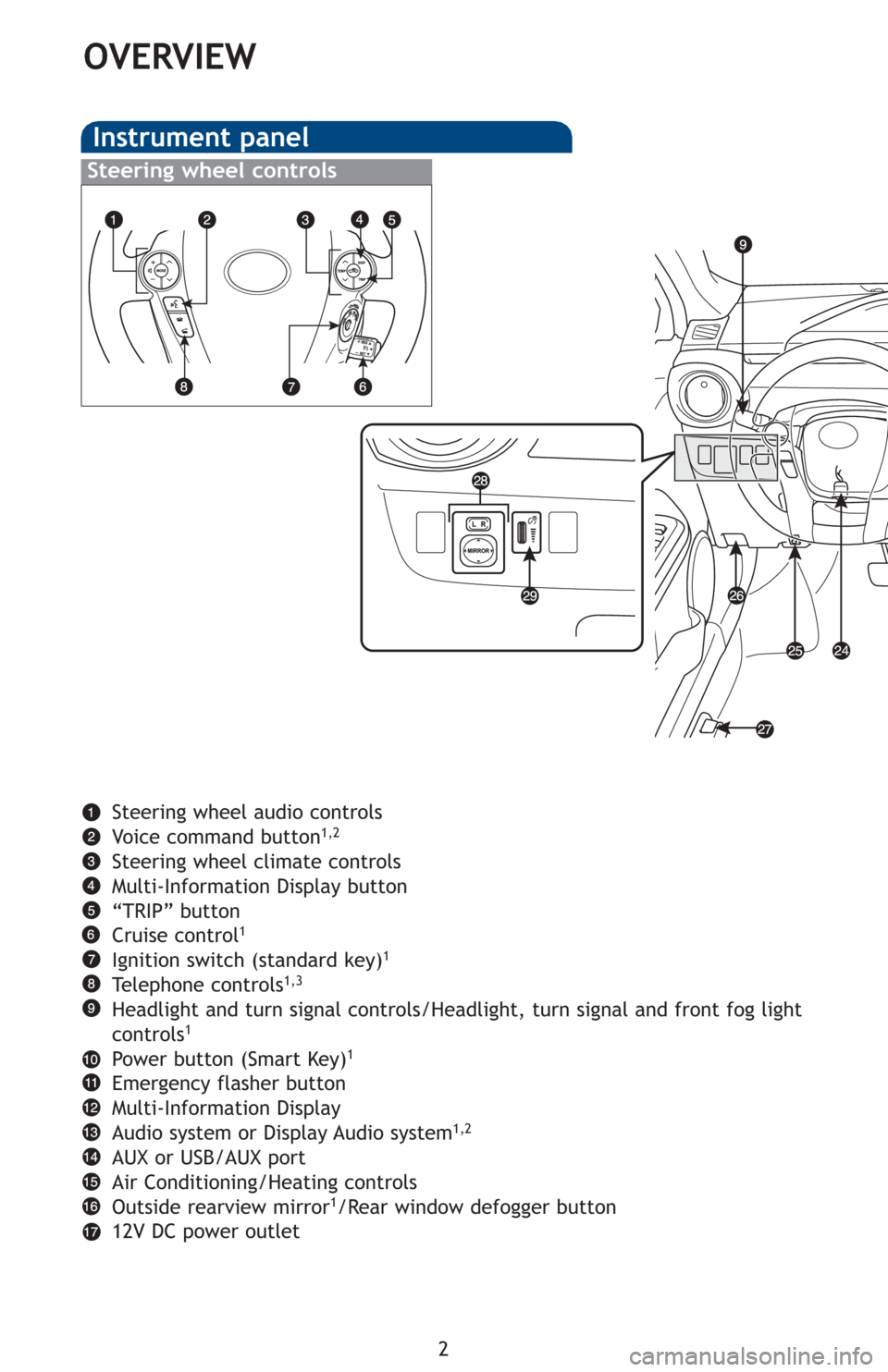
2
OVERVIEW
Instrument panel
Steering wheel controls
Steering wheel audio controls
Voice command button1,2
Steering wheel climate controls
Multi-Information Display button
“TRIP” button
Cruise control
1
Ignition switch (standard key)1
Telephone controls1,3
Headlight and turn signal controls/Headlight, turn signal and front fog light
controls1
Power button (Smart Key)1
Emergency flasher button
Multi-Information Display
Audio system or Display Audio system
1,2
AUX or USB/AUX port
Air Conditioning/Heating controls
Outside rearview mirror
1/Rear window defogger button
12V DC power outlet
Page 5 of 31
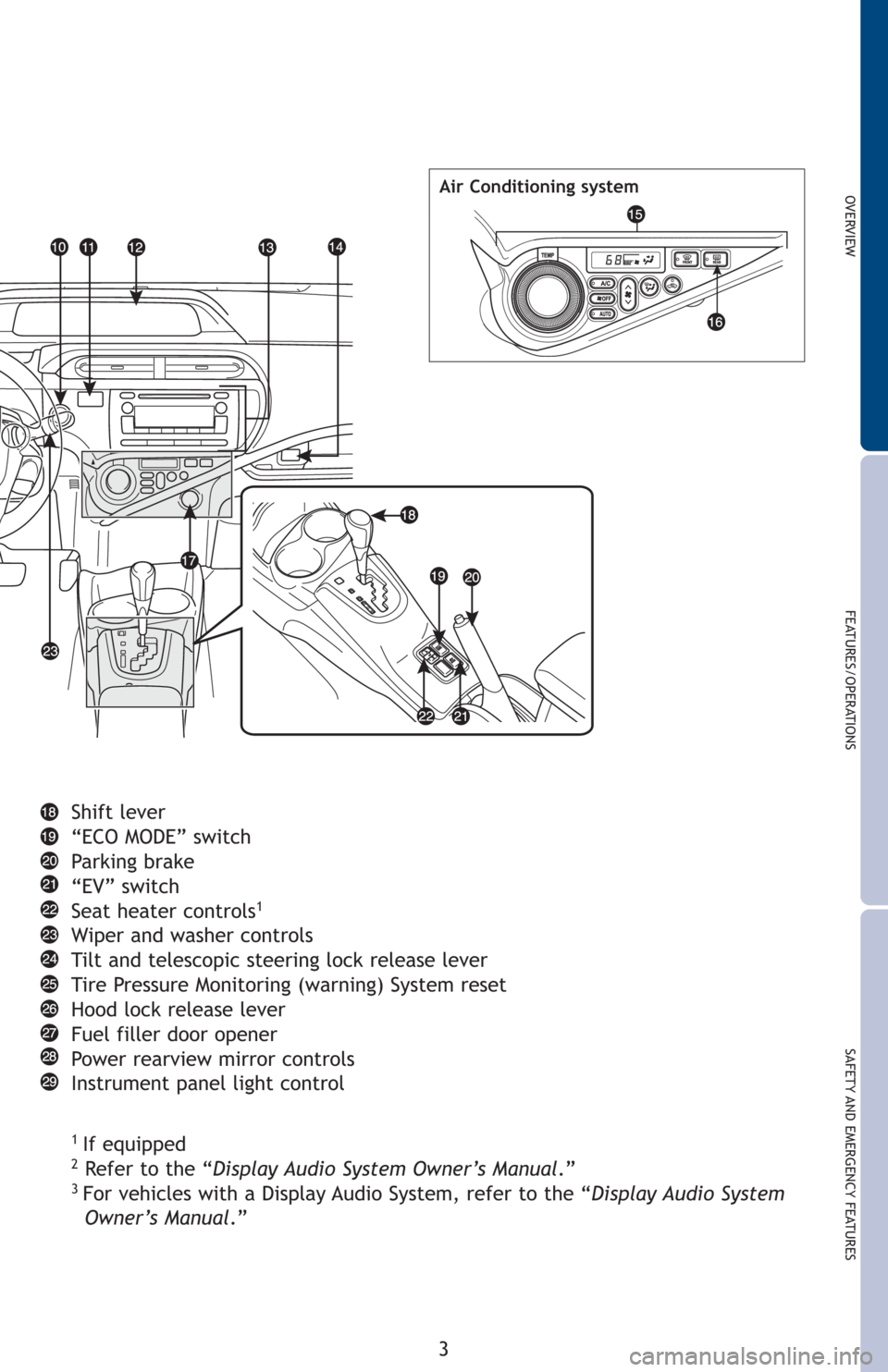
OVERVIEW
FEATURES/OPERATIONS
SAFETY AND EMERGENCY FEATURES
3
Air Conditioning system
Shift lever
“ECO MODE” switch
Parking brake
“EV” switch
Seat heater controls
1
Wiper and washer controls
Tilt and telescopic steering lock release lever
Tire Pressure Monitoring (warning) System reset
Hood lock release lever
Fuel filler door opener
Power rearview mirror controls
Instrument panel light control
1If equipped2Refer to the “Display Audio System Owner’s Manual.”3For vehicles with a Display Audio System, refer to the “Display Audio System
Owner’s Manual.”
Page 6 of 31
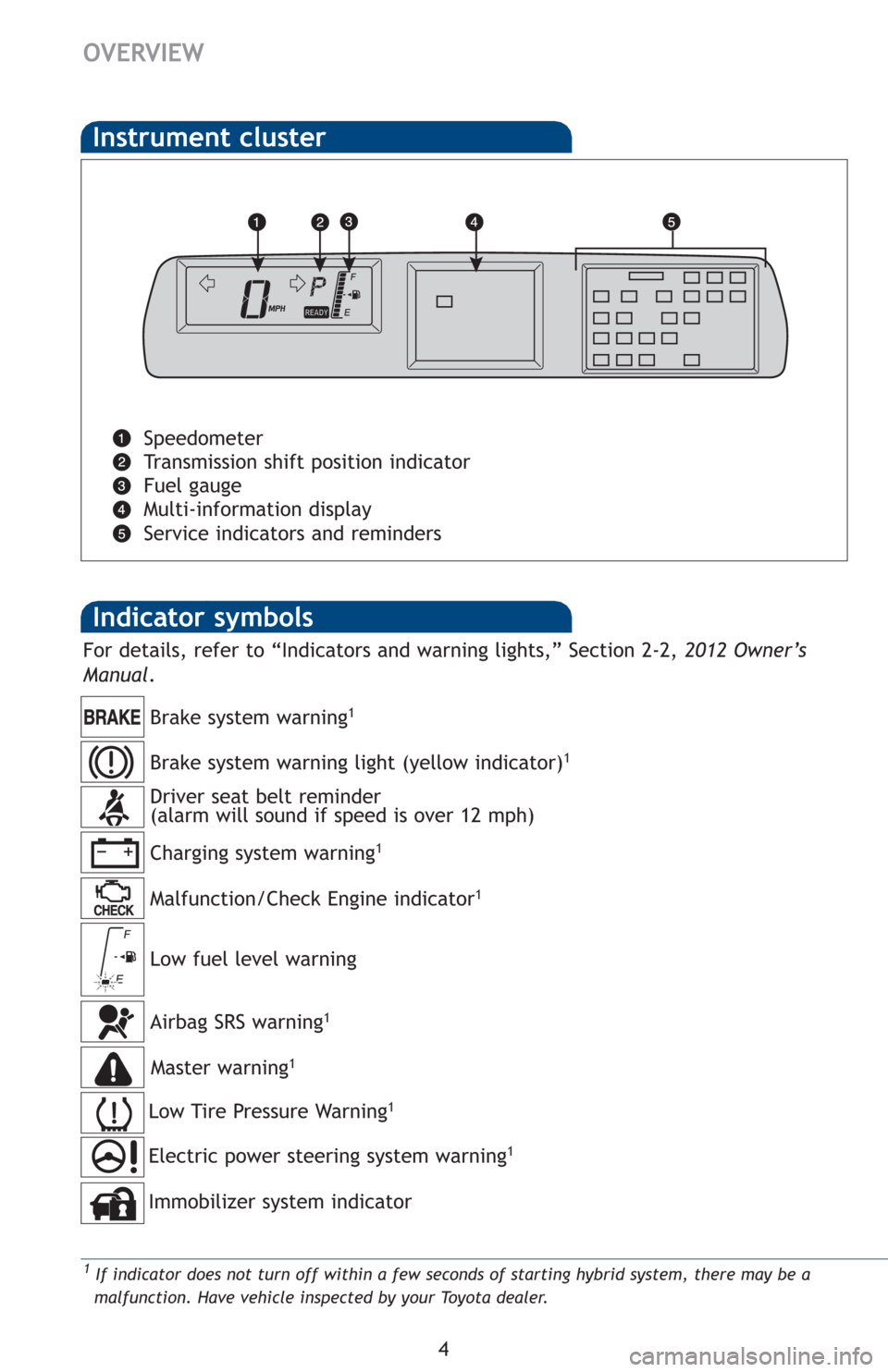
4
OVERVIEW
Indicator symbols
Instrument cluster
Speedometer
Transmission shift position indicator
Fuel gauge
Multi-information display
Service indicators and reminders
Charging system warning1
Brake system warning1
Low Tire Pressure Warning1
Immobilizer system indicator
Airbag SRS warning1
Master warning1
Driver seat belt reminder
(alarm will sound if speed is over 12 mph)
Malfunction/Check Engine indicator
1
Low fuel level warning
Electric power steering system warning1
Brake system warning light (yellow indicator)1
1
If indicator does not turn off within a few seconds of starting hybrid system, there may be a
malfunction. Have vehicle inspected by your Toyota dealer.
For details, refer to “Indicators and warning lights,” Section 2-2, 2012 Owner’s
Manual.
Page 21 of 31
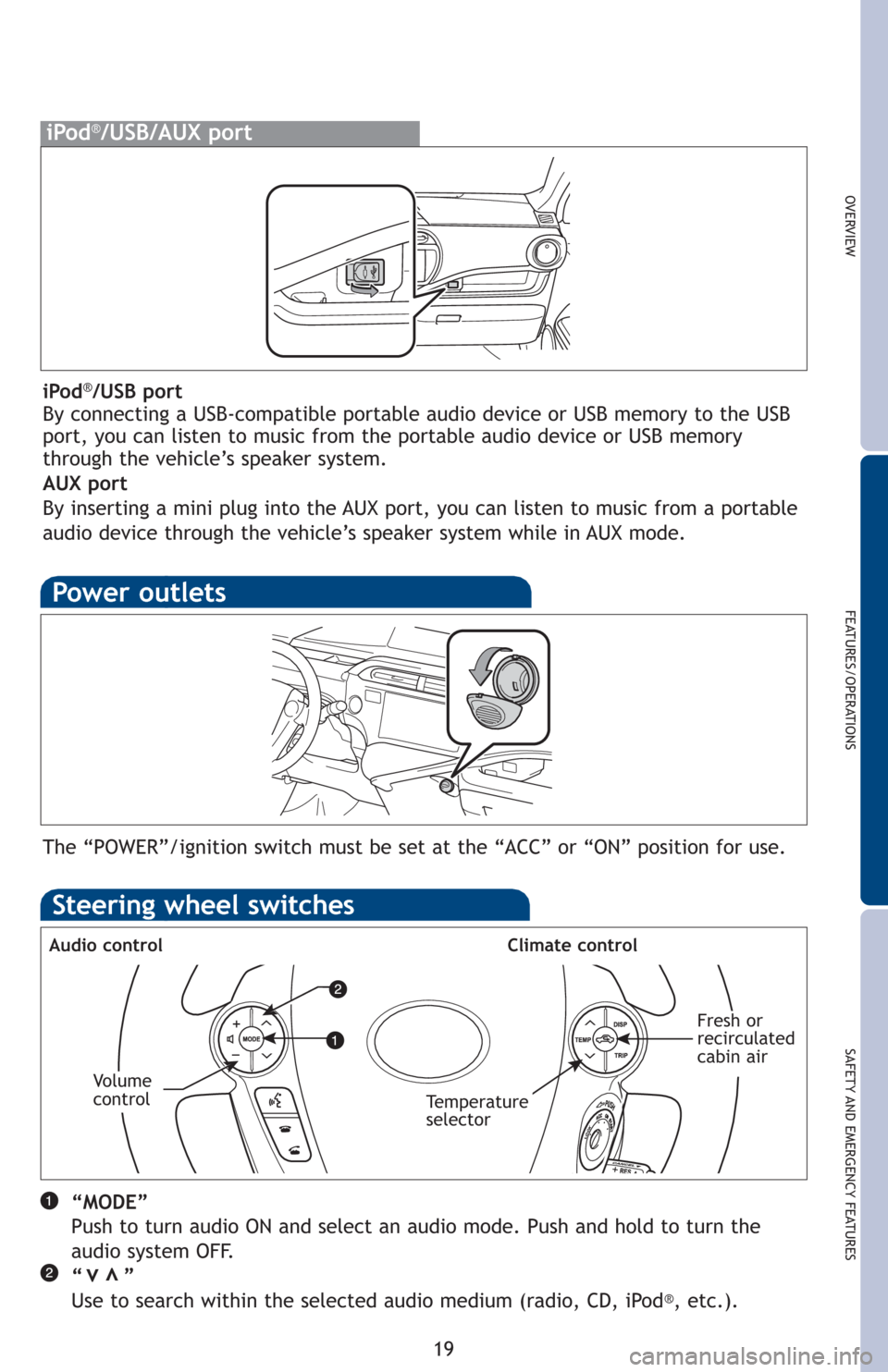
OVERVIEW
FEATURES/OPERATIONS
SAFETY AND EMERGENCY FEATURES
19
iPod®/USB/AUX port
Power outlets
The “POWER”/ignition switch must be set at the “ACC” or “ON” position for use.
Steering wheel switches
Audio controlClimate control
“MODE”
Push to turn audio ON and select an audio mode. Push and hold to turn the
audio system OFF.
“ ”
Use to search within the selected audio medium (radio, CD, iPod
®, etc.).
vv
Vo l u m e
controlTemperature
selector
Fresh or
recirculated
cabin air
iPod®/USB port
By connecting a USB-compatible portable audio device or USB memory to the USB
port, you can listen to music from the portable audio device or USB memory
through the vehicle’s speaker system.
AUX port
By inserting a mini plug into the AUX port, you can listen to music from a portable
audio device through the vehicle’s speaker system while in AUX mode.
Page 23 of 31
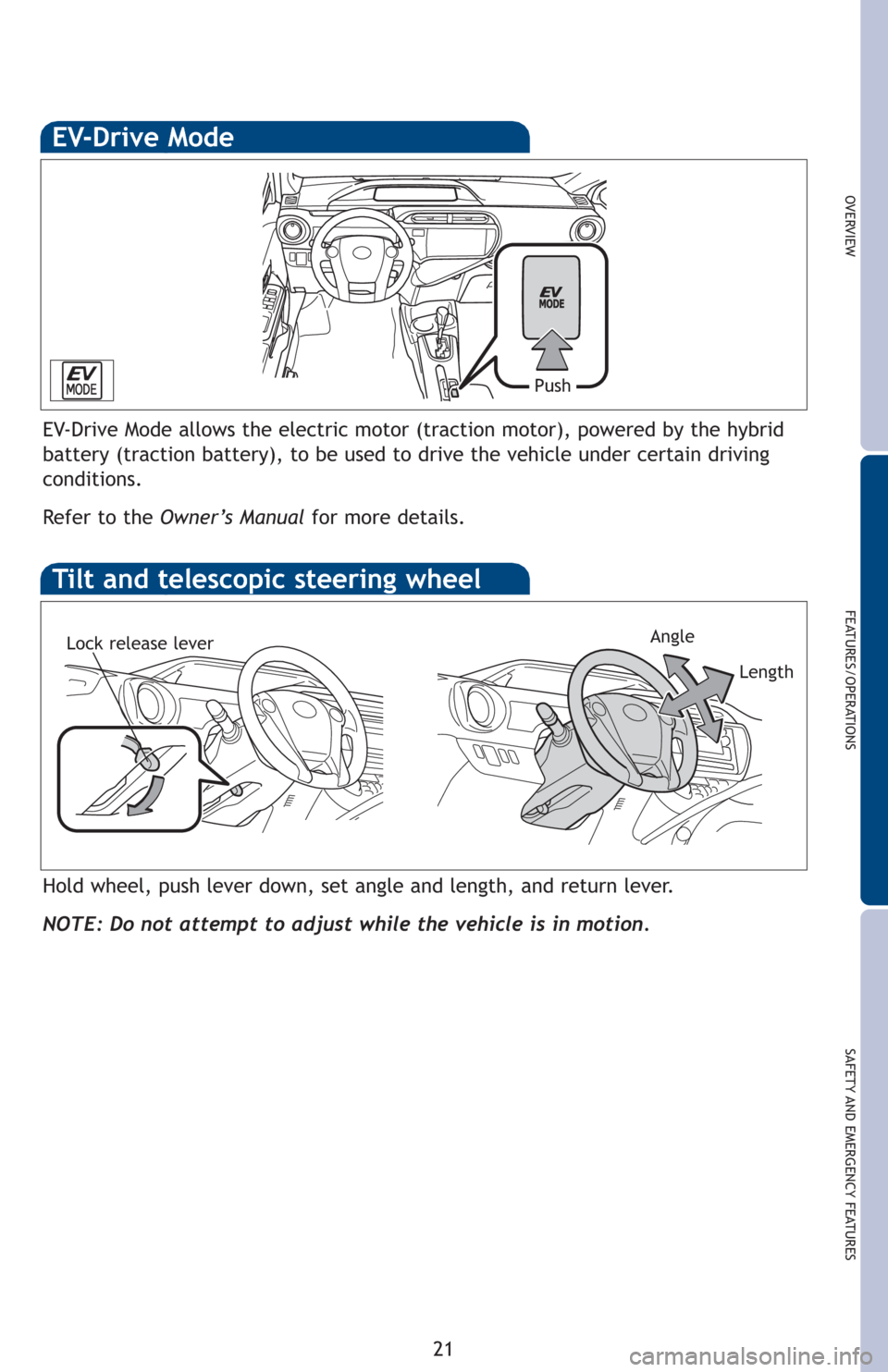
OVERVIEW
FEATURES/OPERATIONS
SAFETY AND EMERGENCY FEATURES
21 Hold wheel, push lever down, set angle and length, and return lever.
NOTE: Do not attempt to adjust while the vehicle is in motion.
Tilt and telescopic steering wheel
EV-Drive Mode
EV-Drive Mode allows the electric motor (traction motor), powered by the hybrid
battery (traction battery), to be used to drive the vehicle under certain driving
conditions.
Refer to the Owner’s Manualfor more details.
Push
Angle
Length
Lock release lever
Page 25 of 31
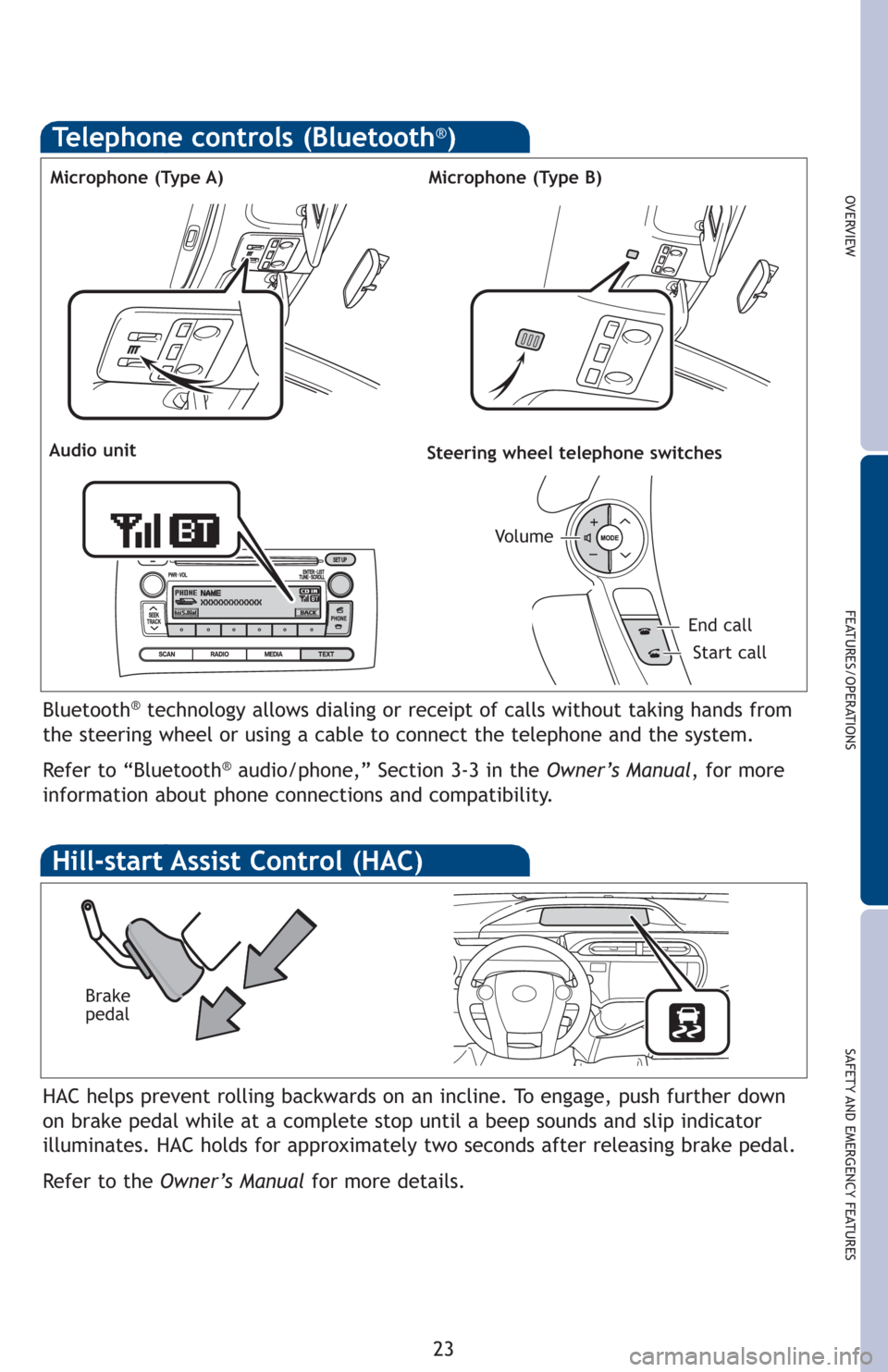
OVERVIEW
FEATURES/OPERATIONS
SAFETY AND EMERGENCY FEATURES
23
Bluetooth®technology allows dialing or receipt of calls without taking hands from
the steering wheel or using a cable to connect the telephone and the system.
Refer to “Bluetooth
®audio/phone,” Section 3-3 in the Owner’s Manual, for more
information about phone connections and compatibility.
Microphone (Type A)
Audio unitSteering wheel telephone switches
Vo l u m e
Start call
End call
Microphone (Type B)
HAC helps prevent rolling backwards on an incline. To engage, push further down
on brake pedal while at a complete stop until a beep sounds and slip indicator
illuminates. HAC holds for approximately two seconds after releasing brake pedal.
Refer to the Owner’s Manualfor more details.
Brake
pedal
Hill-start Assist Control (HAC)
Telephone controls (Bluetooth®)
Page 28 of 31
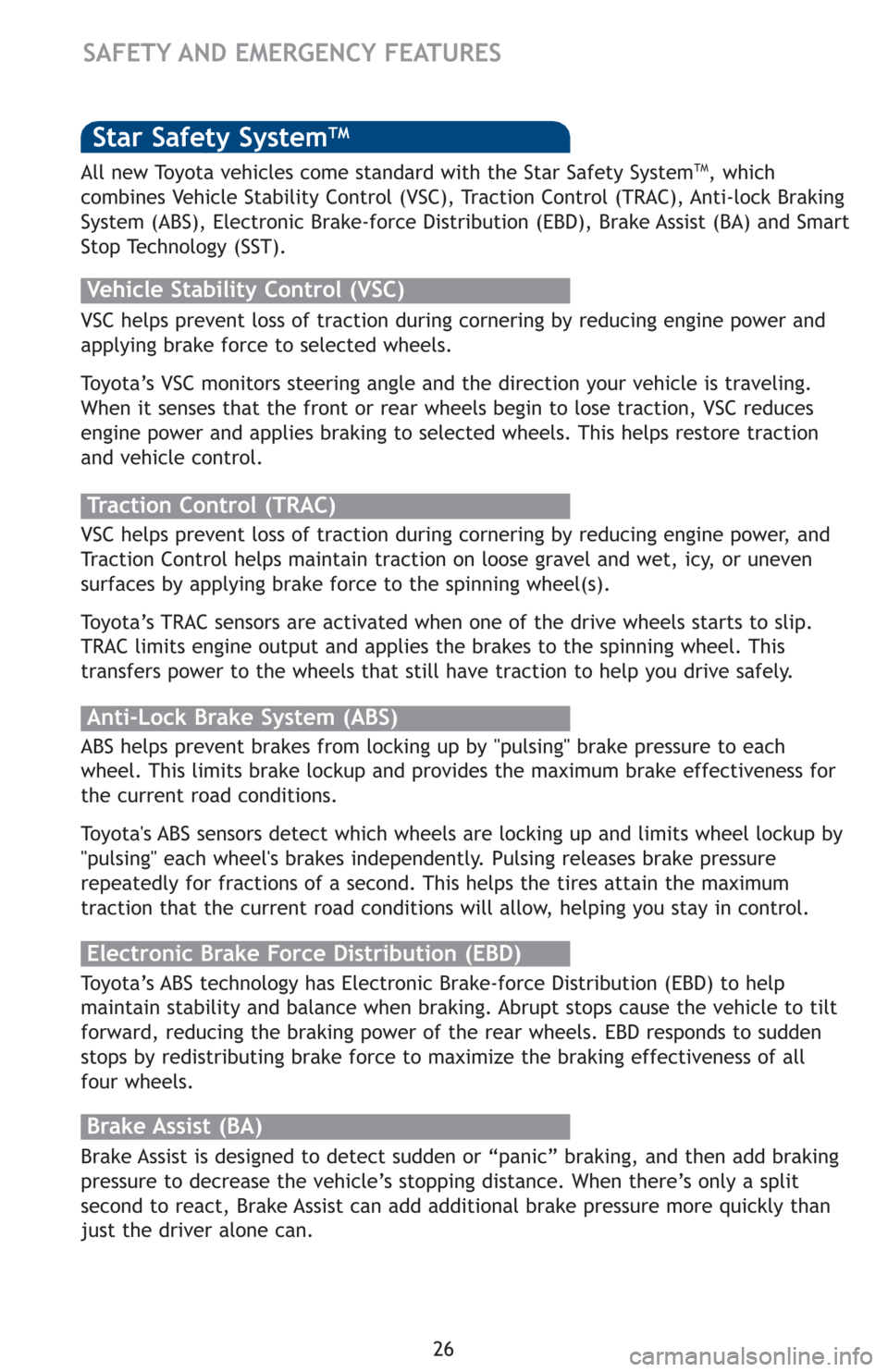
26
Star Safety SystemTM
VSC helps prevent loss of traction during cornering by reducing engine power and
applying brake force to selected wheels.
Toyota’s VSC monitors steering angle and the direction your vehicle is traveling.
When it senses that the front or rear wheels begin to lose traction, VSC reduces
engine power and applies braking to selected wheels. This helps restore traction
and vehicle control.
Vehicle Stability Control (VSC)
Anti-Lock Brake System (ABS)
Brake Assist (BA)
ABS helps prevent brakes from locking up by "pulsing" brake pressure to each
wheel. This limits brake lockup and provides the maximum brake effectiveness for
the current road conditions.
Toyota's ABS sensors detect which wheels are locking up and limits wheel lockup by
"pulsing" each wheel's brakes independently. Pulsing releases brake pressure
repeatedly for fractions of a second. This helps the tires attain the maximum
traction that the current road conditions will allow, helping you stay in control.
Brake Assist is designed to detect sudden or “panic” braking, and then add braking
pressure to decrease the vehicle’s stopping distance. When there’s only a split
second to react, Brake Assist can add additional brake pressure more quickly than
just the driver alone can. VSC helps prevent loss of traction during cornering by reducing engine power, and
Traction Control helps maintain traction on loose gravel and wet, icy, or uneven
surfaces by applying brake force to the spinning wheel(s).
Toyota’s TRAC sensors are activated when one of the drive wheels starts to slip.
TRAC limits engine output and applies the brakes to the spinning wheel. This
transfers power to the wheels that still have traction to help you drive safely.
Traction Control (TRAC)
Electronic Brake Force Distribution (EBD)
Toyota’s ABS technology has Electronic Brake-force Distribution (EBD) to help
maintain stability and balance when braking. Abrupt stops cause the vehicle to tilt
forward, reducing the braking power of the rear wheels. EBD responds to sudden
stops by redistributing brake force to maximize the braking effectiveness of all
four wheels.
SAFETY AND EMERGENCY FEATURES
All new Toyota vehicles come standard with the Star Safety SystemTM, which
combines Vehicle Stability Control (VSC), Traction Control (TRAC), Anti-lock Braking
System (ABS), Electronic Brake-force Distribution (EBD), Brake Assist (BA) and Smart
Stop Technology (SST).